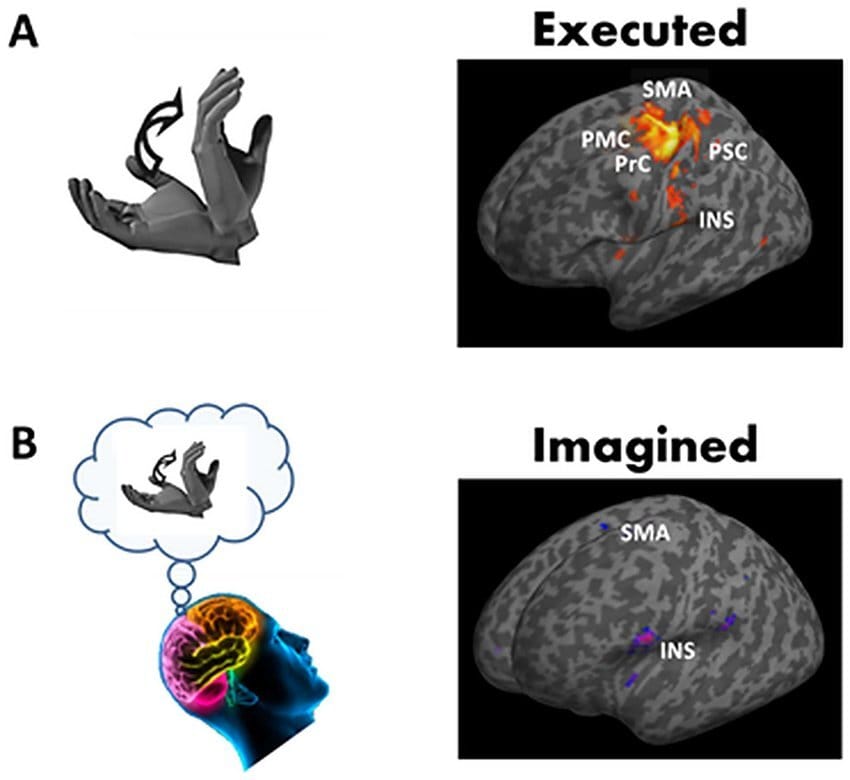- Deltoros Insider
- Posts
- The Power of Visualization Before Heavy Lifts
The Power of Visualization Before Heavy Lifts
2 Min Read
Top athletes and lifters use this mental technique to prime their bodies and minds for success.

In this newsletter, we’ll explore how visualization can enhance your strength training and provide simple strategies to incorporate it into your routine.
What is Visualization?
Visualization is the process of mentally picturing yourself performing an action before you physically do it.
In the context of weightlifting, it means mentally going through your entire lift—every movement, every breath—before you step up to the barbell.
This mental rehearsal trains your brain to execute the lift with precision, focus, and confidence.
"Visualization is the secret weapon of top lifters. What you can see in your mind, you can achieve with your body."
Visualization is about more than just "thinking" about the lift; it involves using your imagination to engage your senses—what you feel, how the barbell moves, and even how the lift will sound.
This prepares your mind and muscles to work together seamlessly.
How Visualization Boosts Your Lifts
You might wonder how simply imagining a lift can actually improve your strength or performance.
It turns out, the mind-body connection plays a huge role in physical performance. Here’s how visualization works to your advantage:
1. Increases Focus and Mental Clarity
When you mentally rehearse a lift, you’re focusing on every detail of the movement: the setup, the grip, the tension in your muscles, and the lift itself.
This intense focus primes your brain to be more engaged during the actual lift. You’re not distracted or second-guessing yourself—you’ve already seen yourself succeed.
Key Takeaway: Visualization helps eliminate distractions and enhances focus, keeping you in the zone when it’s time to lift.
2. Builds Confidence and Reduces Anxiety
Heavy lifts can feel intimidating, especially when you're pushing past personal limits. Visualization helps reduce anxiety by making the lift feel familiar.
When you’ve mentally rehearsed it several times, it doesn’t seem as daunting because your brain already knows what to expect.
Pro Tip: Visualizing a successful lift can boost your confidence, helping you approach the barbell with a winning mindset.
3. Improves Muscle Memory and Movement Efficiency
Your brain controls your muscles, and by mentally rehearsing your lifts, you strengthen the neural pathways that control the movement.
This helps create better muscle memory and more efficient movement patterns. When it’s time to perform, your body moves more fluidly and with better coordination.
Key Takeaway: Visualization reinforces muscle memory, making your lifts smoother and more controlled.

How to Visualize Your Lifts
Visualization is a skill that takes practice, just like lifting itself.
Here’s a step-by-step guide on how to effectively visualize your lifts before hitting the weights:
1. Find a Quiet Space
Before your lift, find a quiet spot where you won’t be interrupted.
Close your eyes and take a few deep breaths to center yourself.
The goal is to clear your mind and focus fully on the lift you’re about to perform.
2. Picture Every Detail
Start by imagining the setup of your lift.
If you’re about to perform a deadlift, for example, picture yourself walking up to the barbell, positioning your feet, and gripping the bar.
Imagine the weight of the barbell in your hands and the tension in your muscles.
Pro Tip: Engage all of your senses during visualization. Feel the texture of the bar in your hands, hear the sound of your breath, and even sense the slight wobble of the weights.
3. Visualize the Perfect Execution
Now, mentally walk yourself through the lift.
If it’s a squat, imagine yourself lowering down, feeling the muscles in your legs and core engage, and then powering back up to a standing position.
Picture the bar moving smoothly and efficiently. Imagine completing the rep with perfect form and strength.
Key Takeaway: Focus on the success of the lift. Visualize yourself completing it confidently and powerfully.
4. Repeat the Visualization
Run through the entire lift a few times in your mind.
The more detailed and realistic your visualization, the better prepared your brain will be to execute the lift when you actually perform it.
The Science Behind Visualization
You might be wondering how visualization can actually impact your physical performance.
Research shows that mental rehearsal activates many of the same neural pathways as physically performing the movement.
This means that when you visualize a lift, your brain is "practicing" the movement without your body actually doing it.
Over time, this mental practice improves your ability to execute the lift in real life.
1. Activates the Motor Cortex
The motor cortex in your brain controls voluntary muscle movement.
Studies have shown that when you visualize an activity, the motor cortex becomes activated, much like when you physically perform the movement.
This mental rehearsal strengthens the connection between your brain and muscles, leading to improved coordination and performance.
2. Builds Mental Toughness
Visualization also helps build mental toughness.
By imagining yourself succeeding, you’re training your mind to push through challenges and overcome doubts.
This mental resilience is key when lifting heavy weights or attempting new personal bests.
Pro Tip: Combine visualization with affirmations like “I am strong enough to lift this weight” to reinforce positive thinking and boost mental toughness.

Watch: How to Use Visualization to Improve Your Lifting Performance
Want to see visualization in action?
Watch this video for a step-by-step guide on how to use mental rehearsal to improve your lifts and maximize your strength gains.
Frequently Asked Questions (FAQs)
1. How does visualization help with weightlifting?
Visualization helps improve focus, confidence, and muscle memory by mentally rehearsing the lift before performing it. This primes your brain and muscles to work together more efficiently during the actual lift.
2. Can visualization really improve my strength?
Yes! Studies show that mental rehearsal can strengthen the neural pathways that control movement, leading to better performance, coordination, and even increased strength over time.
3. How often should I visualize my lifts?
Ideally, you should visualize your lifts before every heavy session. Spending just a few minutes mentally rehearsing each lift can make a noticeable difference in your performance.
4. Is visualization only for advanced lifters?
No! Visualization is a tool that can benefit lifters of all levels. Whether you’re a beginner or experienced, mental rehearsal can help you improve focus and build confidence before heavy lifts.
5. Can I visualize my entire workout, or should I focus on specific lifts?
You can do both. Focus on specific lifts that are challenging or heavy, but also visualize the flow of your entire workout to mentally prepare for the full session.
Conclusion
Visualization is a powerful tool that can take your lifting game to the next level.
By mentally rehearsing your lifts, you improve focus, reduce anxiety, and strengthen the connection between your brain and muscles.
The result? Smoother, more powerful lifts and greater confidence in the gym.
Start incorporating visualization into your routine and watch your strength and performance soar.